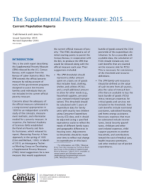The Supplemental Poverty Measure: 2015
The Supplemental Poverty Measure: 2015
Report Number: P60-258
Introduction
This is the sixth report describing research on the Supplemental Poverty Measure (SPM) released by the U.S. Census Bureau, with support from the Bureau of Labor Statistics (BLS). The SPM extends the official poverty measure by taking account of many of the government programs designed to assist low-income families and individuals that are not included in the current official poverty measure.
User Note
Once a decade, the CPS ASEC transitions to a new sample design and updates all metropolitan statistical area delineations. As a result, the metropolitan/nonmetropolitan estimates for 2014 and 2015 are not comparable. Click below for more information.
Highlights
- Using the supplemental poverty measure, 45.7 million individuals in the United States fell below the poverty line in 2015, including 11.9 million children and 6.5 million adults age 65 and above.
- The supplemental poverty measure rate declined 1.0 percentage point since 2014, down from 15.3 to 14.3 percent.
- The supplemental poverty rate declined for many groups and no major group experienced a statistically significant increase between 2014 and 2015.
- Without Social Security benefits, the supplemental poverty rate overall would have been 8.3 percentage points higher. This represents about 26.6 million more individuals, including 17.1 million individuals age 65 and older.
- People 65 and older had a supplemental poverty rate of 13.7 percent, equating to 6.5 million people in poverty. Excluding Social Security from income would more than triple the poverty rate for this group, resulting in a poverty rate of 49.7 percent.
- Not including refundable tax credits (the Earned Income Tax Credit and the refundable portion of the child tax credit) in resources would have resulted in an additional 9.2 million individuals falling into poverty, a 2.9 percentage point increase.
- Not accounting for refundable tax credits for children would have resulted in a poverty rate of 22.6 percent rather than 16.1 percent. This difference represents 4.8 million children.
- Taking account of other noncash benefits also lowered poverty rates. For example, Supplemental Nutrition Assistance Program benefits lowered the overall poverty rate by 1.4 percentage points or 4.6 million people.
Figures
Others in Series
Publication
Income and Poverty in the United States: 2015
This report presents data on income, earnings, income inequality & poverty in the United States based on information collected in the 2015 and earlier CPS ASEC.
Publication
Health Insurance Coverage in the United States: 2015
This report presents data on health insurance coverage in the United States based on information collected in the 2016 CPS ASEC.
Publication
Income and Poverty in the United States: 2016
This report presents data on income, earnings, income inequality & poverty in the United States based on information collected in the 2017 and earlier CPS ASEC.
Page Last Revised - October 8, 2021








